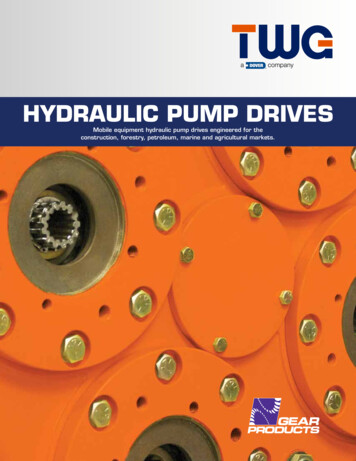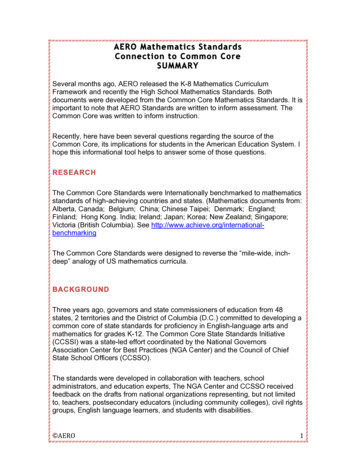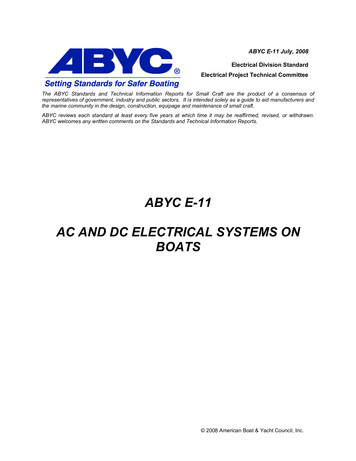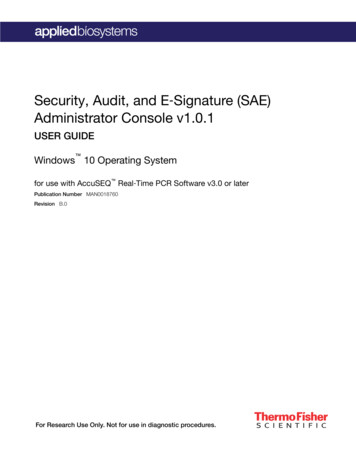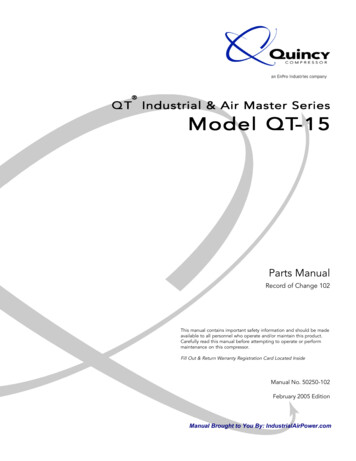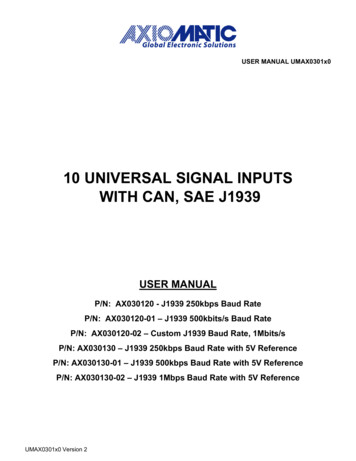
Transcription
SAE Aero DesignFinal ReportAli Alqalaf, Jasem Alshammari, Dong Yang Cao,Darren Frankenberger, Steven Goettl, and John SantoroTeam 16Submitted towards partial fulfillment of the requirements for Mechanical Engineering Design II – Spring 2016Department of Mechanical EngineeringNorthern Arizona UniversityFlagstaff, AZ 86011
Table of Contents1) Introduction . 22) Problem Definition . 2 6Need Statement .2Project Goals 2Objectives .3Constraints 3 63) Concept Generation . 7 194) Fabrication . 20 14Wing .20 21Fuselage 21 22Tail .22 25Electronics .25 26Difficulties .26 275) Flight Calculations . 27 286) Final Design . 29 317) Testing . 31 328) Bill of Materials . 339) Project Plan . 34 3510) Conclusions . . 3511) Acknowledgements . 3612) References . 371
1) IntroductionThe SAE Aero Design Competition is an event that is held annually for college students.Teams from all over the country gather and compete in three unique classes: Regular, Micro, andAdvanced. The capstone team is tasked by Dr. John Tester, NAU SAE Club advisor, with thedesign and construction of an airplane that adheres to the requirements of the Regular classcompetition. There are many constraints that the competition has to make the task complex anddifficult. The competition provides a chance for engineering students to learn something aboutdesigning and building a product and having fun while doing it. Most learning has been done inthe classroom, so this project gives engineering students the chance to get hands on experiencewhich will help in the future for the engineering profession. This report includes the problemdefinition, concept generation, fabrication, and testing of the aircraft.2) Problem DefinitionNeed StatementNorthern Arizona University does not have an airplane design to compete in the SAEAero design competition, so the team is tasked with the design and construction of the airplane.Project GoalsThe goal of this project is to design and build an airplane that satisfies all SAE Aerodesign competition requirements and bring it to competition. This project will be veryeducational in the manufacturing process, as well as the design aspects that will be needed tocomplete the airplane. Writing a report and orally presenting the final product is required, so theteam will compile an exceptional report and presentation detailing the design and manufacturingprocesses.2
ObjectivesTable 01. ObjectivesObjectiveMeasurementUnit of MeasurementCarry max payloadWeightForce pounds (lb)Carry a payload from point ADistanceFeet (ft)DistanceFeet (ft)to BSmall turning radiusTable 1 contains the objectives that the team has decided are critical for the project.Carrying a max payload is important as the competition adheres to teams that can lift the mostweight. To complete a circuit and get a score in the competition, the payload must be movedfrom one point to another. A small turning radius for the aircraft allows for faster circuitcompletion resulting in a higher score in the competition.Constraints1. Aircraft Dimension RequirementThe dimension must not exceed 175 inches [1].2. Material and Equipment Restrictions for Regular ClassThe use of Fiber – Reinforced plastic (FRP) is not allowed, except in the motor mount,propeller, landing gear and control linkage component. Also, not allowed is the use of rubberbands to make the wing retain to fuselage. Furthermore, any types of gyroscopic or otherstability assistance are not allowed [1].3. Aircraft System RequirementsThe airplane requires the use of a electric single motor, gearboxes, belt drive systems,and propeller shaft extensions are allowed in tow condition (one to one propeller to motor RPMshould be maintained) and the prop(s) must rotate at motor RPM [1]. The battery should have: 63
cell (22.2 volt) Lithium Polymer (Li Poly/Li Po) battery pack. The minimum requirements forLi Po battery are: 3000 mAh, 25c) and homemade batteries are prohibited [1]. A 2015 version1000 watt power limiter from the SAE supplier is required and supplied by Neumoters.com [1].For the radio system the battery should have a minimum capacity of 1000 mAh [1].4. Payload RequirementsFor the payload, the team will focus on the interior dimension and we must follow therequirements in Table 2 [1].Table 02. Length Width Height Tolerance For Payload � 0.125”, 0.000”The airplane should have one or more removable access for the payload bay. The payloadinterior surfaces have to be unbroken and smooth. The payload must also be secured to theairframe, as well as contain payload plates. The only penetrations are allowed in the payload baysurfaces is payload support assembly. The support assembly for the payload must be removableand the bay will never considered as payload [1].5. Other RequirementsThe airplane must take off within a maximum distance of 200 ft. Likewise, the airplanemust land within a maximum distance of 200 ft. Also, the time to complete all aerial tasks mustbe no more than 180 seconds [1].4
6. Quality Function Deployment and House of QualityIn Table 3 below, compared are the regular class design requirements with engineeringrequirements. These comparisons are given a score, then the engineering requirements are rankedby importance. Safety, material and motor were found to be the most important.Table 03. Quality Function DeploymentRegular Class ar BoxBatteryRadioSystemInteriorDimensionAIRCRAFT DIMENSIONREQUIREMENT591001009MATERIAL ANDEQUIPMENTRESTRICTIONS FORREGULAR CLASS539991331AIRCRAFT 31309Raw 7%16%16%3%11%9%14%Rank51228674ScaledIn the house of quality, Table 4 below, the team took the engineering requirements from theQuality Function Deployment, Table 3, above to compare them with each other. The comparisonwill help the team know which requirements are related with the others.5
Table 04. House of Quality6
7) Concept Generationa. AirfoilTable 05. Airfoil Weighted Decision MatrixDecision FactorsS1223 CH10 USA22 S1210CriteriaWt.1245CriteriaDefinitionCoefficient of Lift(max)0.25442Coefficient ofLift (max)The airfoil with the highest maximum liftcoefficientDesign LiftCoefficient0.14322Design LiftCoefficientThe airfoil with the proper ideal or design liftcoefficientCoefficient of Drag(min)0.12431Coefficient ofDrag (min)The airfoil with the lowest minimum dragcoefficientLift to Drag Ratio0.35255Lift to DragRatioThe airfoil with the highest lift to drag ratioLift Curve Slope(max)0.15513Lift CurveSlope (max)How much flexibility of site layout is possiblewithout CSS and PHP codePitching he airfoil with the lowest (closest to zero;negative or positive) pitching moment coefficientStall Quality0.15224Stall QualityThe proper stall quality in the stall region (thevariation must be gentle, not sharp).4.53.03.33.1Weighted ScoresThe decision matrix above compares airfoils.The team determined that the lift to drag7
ratio was most important with the maximum coefficient of lift coming in a close second. Thiswas determined because the airfoil with best lift to drag ratio will be most effective for carrying apayload. The highest coefficient of lift combined with the highest lift to drag ratio will give usthe best performing airfoil design. The airfoil the team chose based on the criteria was the S1223airfoil.b. Sweep and Taper Wing ConfigurationTable 06. Sweep and Taper Wing Configuration Weighted Decision MatrixDecision FactorsRECTANGLETAPER DELTAWhich wing configuration do I ightoverall wing weightEases and facilitates the loading andloading0.2433loadingunloading of loads and cargo into andout of cargo aircraftCoefficient ofCoefficient ofThe wing configuration with the0.2543Lift (max)Lift (max)highest maximum lift coefficientCoefficient ofCoefficient of The airfoil with the lowest minimum0.2343Drag (min)Drag (min)drag coefficientLift to DragLift to Drag The airfoil with the highest lift to drag0.2544RatioRatioratioWeighted Scores4.03.83.2The criteria that were deemed most important for the sweep and taper of the wings were:weight, loading, maximum coefficient of lift, minimum coefficient of drag, and lift to drag ratio.The rectangle beats out the other two designs as it as a higher lift to drag ratio, higher maximumcoefficient of drag, and easier in loading and unloading.8
c. Landing Gear ConfigurationTable 07. Landing Gear Configuration Weighted Decision MatrixDecision FactorsTailDraggerCriteria Wt.1Weight 0.165Strength 0.163Coefficient0.165of DragControl 0.51Weighted Scores2.6AttachedBelow TheWing214Bars AttachedTo Fuselage313ParabolicLanding Support443Attached to FuselageWith Support Bar535124253.543.022.843.6The decision matrix above compares different landing gear configurations. The teamdecided that the control of the aircraft on the ground was the most critical criteria. This wasdecided because the team wants to make sure the landing and takeoff will not be an issue at thecompetition. The team’s advisor and mentor both told the team that other teams’ aircrafts had9
crash landings which was the most common way for aircrafts to get eliminated. The criteria thatgave the attached to fuselage with a support bar the edge on the other designs, is the strength andweight. These criterias are also critical because the strength is needed so that the landing geardoes not collapse while landing.d. Fuselage Design(From left to right Rectangular Prism, Cylindrical, Bar Design and Triangular Prism)Table 08. Fuselage Design Weighted Decision itionWeight0.35525WeightOverall weight that thefuselage adds to the planeStrength0.34235StrengthHow much force the fuselagedesign can have exerting onit before it breaksCoefficient0.3of Drag4523CoefficieThe fuselage with the lowestnt ofminimum drag ores10LengthThe shortest fuselage theplane can have
The fuselage is another critical design because it must keep drag to a minimum with alsobe strong with the least amount of weight and length. The less length the fuselage has, the morewidth we can give the wing which creates more lift. The strength, weight and coefficient of dragare weighted more because those criteria will affect the flight of the aircraft more than the lengthof the fuselage. The team decided that the length of the rectangular prism would be easier tominimize than the triangular prism design, while keeping the strength of the fuselage as well.The team also decided that the aircraft could get more volume with a rectangular prism whichmakes loading and unloading the payload bay much easier. The coefficient of drag was also lessbecause the team believed the rectangular prism would have a more continuous airflow over thefuselage when it joins with the horizontal and vertical stabilizers.e. Vertical and Horizontal StabilizersConventional Tail T tailDual Tail11Triple TailTwin Tail
Table 09. Vertical and Horizontal Stabilizers Decision MatrixDecision FactorsConventionaDualT taill StabilityCoefficient0.3043334StabilityThe higher the stability coefficient, theCoefficistraighter the airplane will moveent4pitchingcontrol The horizontal stabilizer prevent up and down(up and motion of the nose of the airplanedown)pitching control0.25(up and down)4432Definitionyaw control(right and left)0.2544335yawcontrol The vertical stabilizer prevent the airplane(right from swinging side to sideand left)Weight0.2044323Weight The weight of the tail4.03.73.02.64.1Weight ScoresThe decision matrix above shows the design scores for vertical and horizontal stabilizers. Thestabilizers job is to pitch (up and down) and yaw (right and left) the airplane. The twin tail design winsbecause it is more stable than most of the other tails. Furthermore, having two vertical stabilizers will helpin being more effective upon other tails in yawing. Also, the height is cut in half if one was to use just onevertical stabilizer.f. Wing Placement Configuration(From left to right Monowing High Placement Monowing Low Placement Biplane)12
Table 10. Wing Placement Configuration Weighted Decision MatrixDecision FactorsMonowing LowPlacementMonowing 1542Weightoverall wing weightLoading0.1453loadingEases and facilitates the loading andunloading of loads and cargo into and outof cargo aircraftCoefficient ofLift (max)0.2545Coefficient of The wing configuration with the highestLift (max) maximum lift coefficientCoefficient ofDrag (min)0.2453Coefficient of The airfoil with the lowest minimum dragDrag (min) coefficientLift to DragRatio0.44524.34.72.9Weighted ScoresLift to DragRatioDefinitionThe airfoil with the highest lift to dragratioBased on the criteria, the top two designs were the monowing high and low placement.Low placement beats the high wing placement slightly in weight and maximum coefficient oflift. The high placement design beats out the low placement design, because it offers a smallercoefficient of drag, higher lift to drag ratio, and ease of loading.g. Payload Configuration13
Decision FactorsCriteriaPayload (max)WeightWt.0.150.40Cost0.30Ease of0.15ConstructionWeighted ScoresTable 11. Payload Configuration Weighted Decision MatrixBox w/Spring Removable Box w/Hinged LoadedCenterSlidingLidPlates Seam BoxLid1234CriteriaDefinition3333Payload (max) Overall payload weight3214WeightTotal weight of configurationCost of payload configuration2132CostmaterialEase of4134Time required to constructConstruction2.91.72.23.3Shown above are the payload configuration design concepts. Also above, is the decisionmatrix for the payload configuration. The payload configuration holds the payload in place in thefuselage. In terms of criteria, weight was deemed the most important, followed by cost, andpayload and ease of construction. Design option 1 and design option 4 were the two highestranking designs. Design option 4, the box with the sliding lid as it slightly edged option 1 inregards to weight and cost.14
h. Material ComparisonDesign 1: Plastic http://www.aliexpress.com Design 2: WoodDesign 3: foam http://forums.sjgames.com h ttps://commons.wikimedia.orgDesign 4: Aluminum h ttp://www.omnisteelsupply.comTable 12. Material Comparison Weighted Decision MatrixDecision 20formationCost0.40Weighted nCostDefinitionOverall material weightStrong or weakThe strength needed to formatthe materialCost of the materialThe decision matrix above shows the criteria of the material the team is going to use for amajority of the airplane parts. In regards to material selection, strength, cost, weight, andformation are all important factors. The wood has the highest scoring material. It is easy to form,cheap, and has good strength.15
i. Receiverdesign 1, 2, 3: www.spektrumrc.comDecision FactorsCriteria Wt.weight 0.3loading 0.2time period recorded 0.2altitude recorded 0.2Quality 0.1Weighted ScoresTable 13. Receiver Weighted Decision Matrix4 Channel6 Channel7 eiver123Criteria DefinitionThe receiver with theweight550minimum weightThe receiver with minimumloading332loadingtime period The receiver with therecorded suitable time period555recordedaltitude The receiver with the454recorded expected altitude recordedThe receiver should be withQuality545the best quality4.24.32.5The decision matrix above compares different aircraft receivers. The team decided thatthe most important criteria is the weight of the receiver, with loading time period recorded,altitude recorded and quality following. Based on these criteria and the scorings, the team used a6 channel aircraft receiver.16
j. Transmitterdesign 4, 5, 6: www.spektrumrc.comDecision FactorsCriteria Wt.Weight 0.2loading 0.3attenuate transmitsignal 0.2gains 0.1losses 0.2Weighted Scores Table 14. Transmitter Configuration Weighted Decision Matrix5 channel7 channelTransmitte 6 channel transmittertransmitterrWhich transmitter do I use?124Criteria Definition415Weight overall transmitter weighttransmitter loading should be as200loading small as possibleattenuate the transmitter should transmittransmit suitable signal to the radio533signal station555gains the ability of gaining signals341losses the ability of losses signals3.52.12.3This decision matrix above compares transmitters. Weight, loading, signal, gains, and losses areall important criteria when choosing a transmitter. Based on the criteria, and their relativeweights, the team used a 5 channel transmitter.k. Servo17
Table 15. Servo Decision MatrixStandard RC high powerDecision tage0.3035Voltage1.51.54.8Weighted ScoresDefinitionTorqueThe higher the torque coefficient the better thecoefficient servo isThe faster the speed is the butter servoto fit the planehigher the voltage leads to faster servomovement and more powerIn the decision matrix for the servo shown are the different criteria: torque coefficient,speed, size, and voltage. Also shown are the design concepts. From there, the team chose thetorque coefficient and the size are the criteria that were to be focused on because the torquecoefficient will decide how powerful the handling will be and for the size the team is committedto certain area specialty with the wing.l. Speed ControllerDecision oefficientspeed0.3stabilityspeed option 0.2Weighted ScoresESC:B500 3D/X105052.0Table 16. Speed Controller Decision Matrix12S MAXESC,EC5HEAVY t of receiver batterycoefficientcurrentthe larger the current coefficient the03coefficient more power can handlespeedcontrol force to hold the airplane in35stabilitycertain55speed option to have the the variety of speed2.84.618
The criteria chosen for the speed controller are: voltage coefficient, current coefficient,speed stability, and speed option. The speed stability was deemed to be the most importantcriteria, as it assists in controlling the airplane. Based on the decided criteria and weights, thedetermined speed controller that the team will use is a 12S max heavy duty BEC.m. Motor SizeDecision FactorsCriteria Wt.Brushed1Weight 0.103Thrust 0.303Thrust to0.40Weight Ratio4Control 0.203Weighted Scores3.4Table 17. Motor Size Weighted Decision MatrixBrushlessWhich wing configuration do I use?2Criteria DefinitionOverall weight that the motor adds to the4WeightplaneThe amount of reaction force that the motor5Thrustcan create using the propellerThrust to Weight The ratio between how much weight the4Ratio motor adds to how much thrust it createsHow easy the pilot can control the plane's4Controlspeed4.3The brushless motor is necessary because the control and thrust to weight ratio are betterthan the brushed motor. The brushed motor just does not produce enough control or thrust whichmakes the brushless motor much better for the aircraft. The brushless motor is significantly moreefficient than the brushed motor and that is why is performed better in the decision matrix.4) Fabrication19
WingFigure 01. Final Wing DesignFigure 02. Center Piece of WingThe wing has a specific rib shape to create the most lift with minimal speeds, which are20
the conditions our plane will be flying with in the competition. The design that we decided to gowith is the S1223 airfoil. This design is specific to the SAE competition for lifting a lot of weightwithout moving at high speeds. The team decided to max out the length of the wing to try andcarry a payload of twenty pounds. Our final product for the wing comes out to be 99 inches. Thewing will carry all of the payload weight which gives us the ability to make the fuselage lighterthan normal. The center structure is 3D printed with ABS plastic to ensure the strength that willbe needed to hold the weight of the payload. The final wing design gets the most lift that can beobtained with the speeds that plane will be flying at.FuselageFigure 03. Final Fuselage DesignThe team decided to go with a rectangular prism design instead of using a bar tail or acylindrical shaped fuselage. The team decided to use birch sheets of wood to build the fuselagewith. The team laser cut the pieces and implemented a notched design to help make theconstruction more efficient. The notch design made each piece line up with each other perfectlyjust like a puzzle piece. These notches also allowed for better contact surfaces for the glue to21
adhere to. This fuselage is hollow which makes the plane a lot less lighter than alternate designsfor a fuselage. The final design is lighter than alternate fuselage designs, which allows the planeto handle carrying more weight for the competition which will result in the team’s success incompetition.TailFigure 04. Tail DesignAbove is the tail design for our airplane on solid works. This twin tail design will beattached by super gluing the wooden parts, while attaching the aluminum pipe by washers ineach side and put a screw through it.22
Figure 05. Tail design viewsThe figure above shows the front, top, and right view for our tail design.Figure 06. Tail design23
The figure above shows that each part of the vertical and horizontal stabilizer moves each way,up, and down, and right and left.Figure 07. Tail ConstructionThe figure above shows the construction of the tail. The right two pieces are thehorizontal stabilizer, and the two left pieces are the vertical stabilizer. As shown six rips are usedfor the horizontal stabilizer and four for the vertical.Figure 08. Tail MonokoteThe figure above shows the processing of applying monokote the stabilizers.24
Figure 09. Finalized Tail ConstructionThe figure above shows the finalized construction of the stabilizers. The stabilizers will beattached to the fuselage.ElectronicsFigure 10. Functional DiagramShown above is the functional diagram for the electrical components of the aircraft. Redwires are positive, and black wires are negative. Blue wires denote servo wires. The battery isconnected to the electronic speed control (ESC), which is then connected to the motor with avariable controller allowing for different power settings. The arming plug is connected to thebattery as well, providing a killswitch. This is required by competition rules. Also wired to the25
battery is the battery eliminator circuit (BEC). Connected to the BEC is the receiver via a servowire. This eliminates the need for a separate battery for the receiver. Configured to the receiverare the servos connected to the different control surfaces. The rudder servo and nose gear servoare connected via a y harness, and one will be reversed giving the proper control to the user.There will be one elevator servo and two aileron servos connected to the receiver as well via ay harness. Finally, the receiver is configured to the transmitter wirelessly via a 2.4 Ghz signal.Figure 11Figure 12Figure 13Shown above are a few examples of the electronics implemented in the final design.Illustrated in Figure 8 is a servo mounted to the wing. Connecting the electronics required a lotof soldering, shown in Figure 9. Figure 10 shows the propeller attached to the motor mounted tothe nose of the fuselage.DifficultiesThe team ran into many obstacles throughout the fabrication of the plane. Most of theobstacles that we came across were simply buying things like nuts, washers, bolts, glue, sticksand balsa sheeting to complete the components in the best manner possible. One of the biggestdifficulties that the team ran into was the monokote that needed to be put on every externalsurface of the plane. The monokote process takes very delicate work. The sheets need to beironed on to each of the contact points of the exterior surfaces on the plane. This process istedious and needs to be done with delicacy in order for the monokote to be able to shrink to atight fit. The monokote must be a tight fit in order for the air to flow as smooth as possiblepreventing turbulence. While heating the monokote with a heat gun to make it shrink, it is very26
easy to put a hole in the surface. The monokote also needed more surface area to stick to than theteam had anticipated. To move past this obstacle with a good final product on the wing,horizontal stabilizer and vertical stabilizer the team glued on balsa sheeting along the edges ofeach of the components. This resulted in much tighter fit monokote which will in the end makethe plane flights go much smoother.5) Flight CalculationsFigure 14. Flight calculation inputs.Above is the inputted information into the online calculator that solves for the performance ofthe aircraft with the selected final components.Figure 15. Flight calculation results27
Figure 16. Flight calculation results.Above is the results that was given from the online calculator that shows how the aircraft willperform at the competition. It uses the elevation of the airfield and the weight and power fromeach component to solve for the performance.Figure 17. Flight calculation results.A graph of the results are given graphically above.28
6) Final DesignThe final design and fabrication of the aircraft has the dimensions of 99” wingspan by55” fuselage length by 19” tall to the tip of the vertical stabilator. The total combined lineardimensions of the aircraft is 173”. This is just 2” short of the 175” dimension constraint. Theaircraft features heavy duty aluminum tricycle landing gear able to absorb the high stress oflanding with a payload. Attached to the landing gear are 4” tubeless rubber tires on high strengthplastic wheels. The aircraft features unique control surfaces utilizing a stabilator design approachwhich provides more control than traditional control surface designs. Mounted on the front of theaircraft is a 22.2 volt dc motor with a 18” diameter propeller attached to it. The figures belowshow the aircraft after the fabrication phase.Figure 14. Final Design North West IsometricFigure 15. Final Design North Isometric29
Figure 16. Final Design North East IsometricIn addition, the team made multiple modifications to the final prototype. Currently, theteam’s motor has its coil exposed to the air. During flight, this exposure could lead to moisture ordebris interfering with the motor causing a malfunction. To prevent this from happening, acowling will be added to cover the motor. The cowling will be designed and manufactured usingrapid prototyping. Secondly, the vertical stabilizers in the current design are subject to a smallamount of deflection. To fix this, a small bar will be added to the vertical stabilizers to achievemore stability and control. Thirdly, the nose gear servo needs adjustment, as a reverse servo isrequired for the current design. Finally, in the current design, the aircraft’s center of gravity liesat about a half chord. To achieve balance, an aircraft’s center of gravity needs to lie at a quarterchord from the leading edge of the wing. The team will accomplish this by moving internalelectrical components towards the front of the airplane’s fuselage. Also, the insertion of payloadplates will help the team obtain a more desirable center of gravity. Shown in Figure 17 below isthe team’s final prototype with the modifications added.30
Figure 17. Final Prototype with modifications.7) TestingTo test the aircraft we followed the competition objectives. The team was going to havethe plane take off and land within the same 200 feet of runway and fly a 360 degree degree turnin order to complete these objectives. From start to finish the pilot had 3 minutes to finish theentire process.During the testing the team had to make some on the scene modifications to ensure thetest could be done. A modification that the team had to make was adding size to the front tire sothat the propeller would not hit the ground while taking off and landing. The team did this byadding material around the tire continuously all around the tire. This was a necessary fix becausewhen the propeller would hit the ground the plane would naturally start to turn. This fixed theteam’s problem and allowed for effective testing of the plane.The testing of the aircraft ended in a crash. The team evaluated the testing videos and theplane after the crash carefully. The team concluded that the aileron horn lost connection to theaileron itself resulting in a loss of a critical control surface to the plane. The pilot had no way ofgetting the plane back into control without this feature on the plane. This caused the plane to dipand weave out of control to an inevitable nose dive into the ground. The test had poor results butthe team was still able to get useful information that can help modify future manufacturingprocess of a plane. Figure 18 below illustrates the testing result.31
Figure 18. Testing Result32
8) Bill of MaterialsTable 18. Bill of MaterialsTable 5 abo
The capstone team is tasked by Dr. John Tester, NAU SAE Club advisor, with the design and construction of an airplane that adheres to the requirements of the Regular class . Northern Arizona University does not have an airplane design to compete in the SAE . For the payload, the team will focus on the interior dimension and we must follow .



